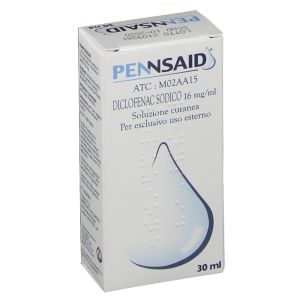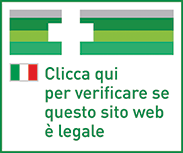Ship in Europe, Find out rates!
Pennsaid 16 mg/ml Diclofenac Sodico Soluzione Cutanea 30 ml

- box Delivery in Italy in 24/48 and free returns
- star3.000+ positive reviews
- dropboxOver 60,000 products in the catalog
Skin solution based on diclofenac sodium.
Therapeutic indications
Pennsaid Cutaneous Solution is a cutaneous solution indicated in the symptomatic relief of pain associated with osteoarthritis of superficial joints, including the knee.
Dosage and posology
Pennsaid is applied locally on the aching joint.
After washing the area to be treated with soap and water and waiting for it to dry, apply about 20 or 40 drops (about 0.5 or 1 ml) of Pennsaid respectively for a medium (e.g. wrist) or large (e.g. . knee). Patients should use up to a maximum of 40 drops four times daily per joint as recommended by the treating physician.
To prevent the product from dripping away from the area to be treated, apply the solution by dividing it into portions of 5 or 10 drops for a medium or large joint.
Distribute Pennsaid evenly on the area to be treated with your hand or fingers. Repeat the process until you have applied the entire recommended dose of Pennsaid. Apply 4 times a day.
Overdose
Pennsaid is to be administered for external use only. The low systemic absorption of diclofenac suggests that cases of topical overdose toxicity are extremely unlikely.
In case of accidental ingestion the quantity of diclofenac sodium (900 mg) contained in a 60 ml bottle of Pennsaid can cause transient gastric disorders and / or renal dysfunction. Absorption should be minimized as soon as possible by administration of activated charcoal. Kidney and gastrointestinal functions should be checked for any irritation or bleeding. Complications such as hypotension, gastrointestinal haemorrhage and renal failure should be treated with symptomatic and supportive treatments. Forced diuresis may be of limited use. The amount of DMSO (36 g) would be well below the minimum hazard levels in humans (based on LD 50 in monkeys> 11 g / kg).
Acute exposure to DMSO from inhalation of high vapor concentrations with the use or abuse of Pennsaid is extremely unlikely. If it occurs, it can cause irritation of the mucous membranes of the upper respiratory tract, wheezing, nausea or vomiting. Therapy involves the administration of oxygen or other symptomatic measures deemed necessary.
Contraindications
- In pregnant and lactating women and in patients with hypersensitivity to diclofenac or other components of the solution.
- Since there may be cases of cross-sensitivity with other non-steroidal anti-inflammatory drugs, even belonging to different groups, diclofenac should not be used in those subjects in which they have occurred, after taking acetylsalicylic acid (ASA) by mouth or by other non-steroidal anti-inflammatory drugs (NSAIDs), asthma attacks, hives, acute rhinitis or other allergic manifestations.
- Allergy or skin sensitivity: Pennsaid also contains dimethyl sulfoxide (DMSO) as a carrier agent and therefore should not be used in patients with a known history of allergy or skin sensitivity to DMSO.
- As there are no clinical data on the use of Pennsaid in pediatrics, it is not recommended for use in this patient group.
Side effects
Undesirable effects are divided into local, therefore related to the area of application, and systemic. Six double-blind controlled clinical trials highlighted the following undesirable effects with a significant increase in incidence in the Pennsaid group compared to the comparator group treated with placebo. At the application site, cases of dry skin (35.8% versus 6.86% in the placebo group) and rash (10.44% versus 2.86% in the placebo group) were statistically significant. Other side effects of PENNSAID, which were statistically significant compared to placebo, are constipation (3.83% vs 0.57%), dyspepsia (8.98% vs 4%) and flatulence (4.49% vs 0.57%). %).
Photoallergic reactions and contact dermatitis have been reported after topical application of diclofenac. The systemic absorption of diclofenac sodium following topical application of Pennsaid is very low compared to that of taking diclofenac sodium tablets. However, when Pennsaid is applied to a relatively large area of the skin for an extended period of time, it will not the possibility of systemic side effects similar to systemic effects caused by oral diclofenac can be completely excluded. Possible systemic side effects are described below.
Pregnancy and breastfeeding
Pennsaid is contraindicated during pregnancy and breastfeeding.
Special warnings
The occurrence of side effects can be reduced by using the lowest effective dose for the shortest time needed to control symptoms.
- Elderly: There is an increased frequency of adverse reactions to oral NSAIDs in the elderly, especially gastrointestinal bleeding and perforation, which can be fatal.
- Patients with a history of gastrointestinal toxicity, particularly if elderly, should report any abnormal abdominal symptoms (especially gastrointestinal bleeding) especially in the initial stages of therapy. Serious skin reactions, some of them fatal, including exfoliative dermatitis, Stevens-Johnson syndrome, and toxic epidermal necrolysis, have been reported very rarely in association with the use of NSAIDs.
- In patients, the greatest risk of such reactions occurs in the initial stages of therapy: the onset of reactions occurs within the first month of therapy in most cases.
Pennsaid therapy should be discontinued at the first appearance of skin rash, mucosal lesions or any other signs of hypersensitivity. Patients should be advised to wash their hands after application to avoid contact with eyes, mucous membranes and skin not involved in the treatment.
No other medicines should be applied to the affected area at the same time as Pennsaid. The likelihood that undesirable effects may occur following topical application is very low when compared with the frequency of occurrence of undesirable effects following oral administration of diclofenac, due to the low systemic absorption of Pennsaid. This medicinal product should be used with caution in patients with impaired renal function as isolated cases of systemic reactions with deterioration of renal function have been observed following oral or topical administration of NSAIDs. The lowest Pennsaid dosage per joint should be considered.
Expiration and retention
Check the expiration date indicated on the package. The expiry date indicated on the package refers to the product in intact packaging, correctly stored.
Warning : do not use the medicine after the expiry date indicated on the package.
Composition
1 ml of Pennsaid cutaneous solution contains:
Active principle
16.05 mg of diclofenac sodium.
Excipients
Dimethyl sulfoxide, ethanol, glycerin, propylene glycol, distilled water.
| Destination | Cost | Detail |
|---|---|---|
| Italy | €5,90* | 24/72H |
| Austria, France, Germany, Slovenia | € 13* | 3 days |
| Belgium, Luxembourg, Portugal, Netherlands, Spain | € 14* | 4 days |
| Bulgary, Cechia, Hungary, Poland, Romania, Slovakia | € 19* | 5 days |
| Denmark, Estonia, Finland, Ireland, Lithuania, Latvia ,Sweden | € 22* | 5 days |
| United Kingdom, Switzerland, Greece, Malta/td> | € 30* | 7 days |
| Canada | € 40 | 7 Days |
European shipments with express courier: FedEx, MBE, DHL
*For the shipment outside band B ther's an extra cost of 22€ *For the shipment outside band C ther's an extra cost of 30€ Delivery Times exclude Saturday and Holidays
For Islands and Areas of difficult Accessibility the shipments are made in 72 hours and the cost will be increased by 15€


